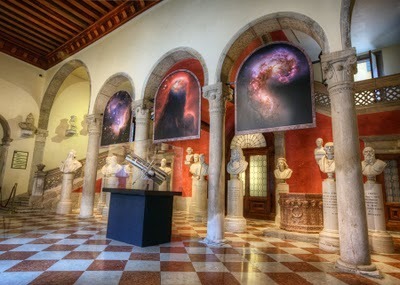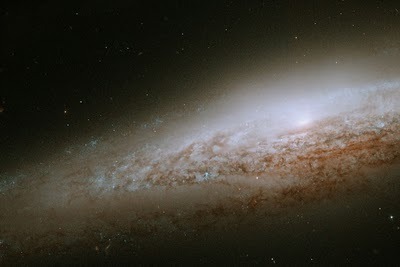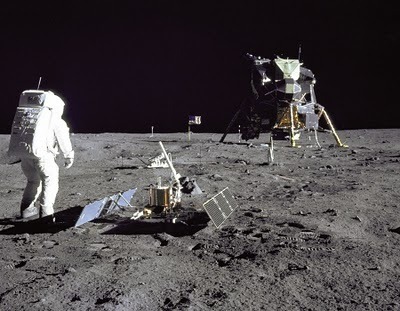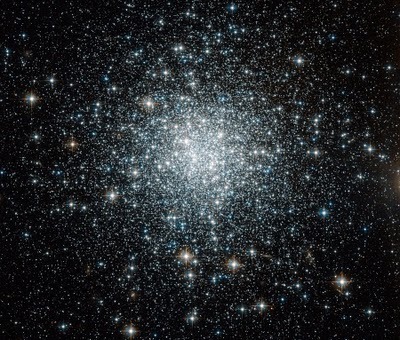Eleanor Arnason's Blog, page 86
October 21, 2010
Loss and Perfection
I began yesterday by breaking a new piece of jewelry: an ammonite fossil, which has managed to acquire a silvery coating of iron pyrite. It fell onto the bathroom floor and broke in two along an old crack, which I had already noticed. There is still ammonite shell inside the fossil, shining like mother of pearl.
Patrick and I are pretty sure we can glue the fossil back together, but it got a little chipped as well. It will not be as perfect as before; and I now know that it is far more fragile than I realized when I bought it. So it may break again.
I have trouble with imperfection, which is one reason I write so slowly. My slowness does not produce perfection. When I finally shove stories out into the world, they are still flawed. But I finally get tired to trying to fix stories that are essentially imperfect, give up and shove. Sometimes, when I read the stories later, I think, "This is really okay." Sometimes I think, "This story does have problems, but it's still worth reading. There are good lines and entertaining ideas."
As I age, I have to deal more and more with loss and with imperfection. So maybe I should learn that our lives are imperfect, and what we make is imperfect.
Some people seem to create art of miraculous quality on a consistent basis. They seem magical: Mozart comes to mind, though I think I like Haydn better, because he worked so hard for so many years, writing music as a job, the way a mason makes stone walls or a butcher cuts meat, and not seeming magical.
There are Chinese pots from the Tang and Sung dynasties that seem magical. You look at them and think, "This is an absolutely flawless pot, the essence of what a pot is and should be."
I think we thank the world and humanity for magical art and artists, and for Haydn, and we keep doing the best we can.
Patrick and I are pretty sure we can glue the fossil back together, but it got a little chipped as well. It will not be as perfect as before; and I now know that it is far more fragile than I realized when I bought it. So it may break again.
I have trouble with imperfection, which is one reason I write so slowly. My slowness does not produce perfection. When I finally shove stories out into the world, they are still flawed. But I finally get tired to trying to fix stories that are essentially imperfect, give up and shove. Sometimes, when I read the stories later, I think, "This is really okay." Sometimes I think, "This story does have problems, but it's still worth reading. There are good lines and entertaining ideas."
As I age, I have to deal more and more with loss and with imperfection. So maybe I should learn that our lives are imperfect, and what we make is imperfect.
Some people seem to create art of miraculous quality on a consistent basis. They seem magical: Mozart comes to mind, though I think I like Haydn better, because he worked so hard for so many years, writing music as a job, the way a mason makes stone walls or a butcher cuts meat, and not seeming magical.
There are Chinese pots from the Tang and Sung dynasties that seem magical. You look at them and think, "This is an absolutely flawless pot, the essence of what a pot is and should be."
I think we thank the world and humanity for magical art and artists, and for Haydn, and we keep doing the best we can.
Published on October 21, 2010 07:14
October 15, 2010
The Sequel to Ring of Swords
My fiction writing group the Wyrdsmiths had a good meeting last night. One of the pieces being critiqued was the first 30 (I think) pages of my current novel Hearth World, which is the sequel to Ring of Swords.
The comments got me excited about working on the novel and gave me good ideas for changes. I had been terrified that people were going to simply, flat-out dislike the story. Instead, they seemed to mostly like it, though two of the three people critiquing felt the the viewpoint character was too remote. I tend to under-write emotion in first drafts and have to go back and make it explicit.
Not too hard to fix.
People liked the hwarhath. That makes sense. The hwarhath are likeable.
The comments got me excited about working on the novel and gave me good ideas for changes. I had been terrified that people were going to simply, flat-out dislike the story. Instead, they seemed to mostly like it, though two of the three people critiquing felt the the viewpoint character was too remote. I tend to under-write emotion in first drafts and have to go back and make it explicit.
Not too hard to fix.
People liked the hwarhath. That makes sense. The hwarhath are likeable.
Published on October 15, 2010 05:31
October 13, 2010
NASA Photo of the Day

Will the Hubble Space Telescope (HST) end up in a museum? Probably not, as when it finally goes bust, current plans call for it to be de-orbited into an ocean. But this won't stop likenesses of the famous floating observatory from appearing in science museums around the globe, sometimes paired with amazing pictures it has taken. Pictured above, in a celebration of the 20th anniversary of the launching of Hubble, a replica of the telescope was given a picturesque setting in the Italian Istituto Veneto di Scienze, Lettere ed Arti in their beautiful and historic Palazzo Loredan. The scene there appears perhaps a bit surreal as the deep space imager appears over a terrestrial tile floor, surrounded by the busts of famous thinkers, and under arches reminiscent of Escher. If you're lucky, it may even be possible to find an exhibition of Hubble images near you. And if no HST model appears there, you could always build your own.
Published on October 13, 2010 09:30
October 11, 2010
October
A poem I wrote after getting back from the North Shore of Lake Superior:
As you might be able to tell from this poem, I love fall, though I don't like it this warm. At the same time, my mood responds to light -- which should be obvious, considering how much I use words like 'bright' and 'shine.' (I think Edmund Spenser, author of The Faerie Queene, also had mood swings in response to light, given how lovingly he described light.)
In any case, while I love fall, my mood also drops a bit as the days grow shorter. It makes for an odd combination; and it leads to mulling.
The days continue too warm for October.
Birches drop round, bright leaves.
Tamarack needles shine softly, like gold.
Out on the great lake, haze hides distance.
Everything is blue, sunlit, almost hot.
I, at the edge of old age, almost wishing
for the comfort of snow-bound winter,
wonder at this land of expanding summer.
As you might be able to tell from this poem, I love fall, though I don't like it this warm. At the same time, my mood responds to light -- which should be obvious, considering how much I use words like 'bright' and 'shine.' (I think Edmund Spenser, author of The Faerie Queene, also had mood swings in response to light, given how lovingly he described light.)
In any case, while I love fall, my mood also drops a bit as the days grow shorter. It makes for an odd combination; and it leads to mulling.
Published on October 11, 2010 08:27
Mulling
Maybe because of the time of the year or my increasing age, I have been mulling over my life and who I am. No conclusions as yet.
Published on October 11, 2010 05:09
Astronomy Photo of the Day

Does spiral galaxy NGC 2683 have a bar across its center? Being so nearly like our own barred Milky Way Galaxy, one might guess it has. Being so nearly edge-on, however, it is hard to tell. Either way, this gorgeous island universe, cataloged as NGC 2683, lies a mere 20 million light-years distant in the northern constellation of the Cat (Lynx). NGC 2683 is seen nearly edge-on in this cosmic vista, with more distant galaxies scattered in the background. Blended light from a large population of old yellowish stars forms the remarkably bright galactic core. Starlight silhouettes the dust lanes along winding spiral arms, dotted with the telltale blue glow of young star clusters in this galaxy's star forming regions.
Photo and commentary courtesy of NASA.
One of the things I like about NASA photos is -- they remind me that there is a large universe beyond our embattled planet, and no matter what happens here, with elections looming and the climate warming, that universe will keep going for a considerable period of time, lighting the skies of other planets for (I hope) other people to see.
Published on October 11, 2010 05:06
October 10, 2010
Remember the Future?

Why are there so many moonquakes? A recent reanalysis of seismometers left on the moon by the Apollo moon landings has revealed a surprising number of moonquakes occurring within 30 kilometers of the surface. In fact, 28 moonquakes were detected in data recorded between 1972 and 1977. These moonquakes were not only strong enough to move furniture but the stiff rock of the moon continued vibrating for many minutes, significantly longer than the soft rock earthquakes on Earth. The cause of the moonquakes remains unknown, with one hypothesis holding that landslides in craters cause the vibrations. Regardless of the source, future moon buildings need to be built to withstand the frequent shakings. Pictured above in 1969, Apollo 11 astronaut Buzz Aldrin stands besides a recently deployed lunar seismometer, looking back toward the lunar landing module.Photo and commentary courtesy of NASA.
Published on October 10, 2010 07:54
Cyber Warfare
Here is an article on cyber warfare, which science fiction writers should pay attention to.
Published on October 10, 2010 07:51
October 9, 2010
Visit
My brother came out for a five-day visit. When Patrick and I go to visit him and my sister-in-law, we spend most of our time lounging around their wonderful, comfortable house, talking and reading and petting numerous cats.
Our place is far smaller, so we tend to take people out more. Wednesday my brother and I went to the Minneapolis Art Institute and looked at Chinese Art. Thursday the three of us drove south along the Mississippi River and looked at fall colors, which are not yet at peak in the southern part of the state. It was a lovely, though too-warm day with a bright, clear, blue sky. Patrick saw an eagle above the road. Neither my brother nor I saw it.
Friday we drove north to Duluth and along the North Shore of Lake Superior to Split Rock Lighthouse. We wandered down to the shore below the lighthouse and watched clear water lap very gently over rocks. The colors along the shore were past their peak, but plenty of birches were still holding their bright yellow leaves. It was another cloudless day, though with a heat haze over the lake. While we were in Duluth, we saw the Edwin Gott, a thousand foot ore carrier, come into Duluth Harbor through the shipping canal and under the Aerial Bridge.
We stayed overnight in Duluth and went onto the Iron Range Saturday to look at Hull Rust, a huge, open-pit iron mine -- three miles long, a mile across and more than 500 feet deep. It is still in operation, but just barely. A half dozen or so gigantic machines labored at the pit's bottom. The birches and aspens on the Range have mostly lost their leaves, but the tamaracks still have their needles, which are a dull, soft gold. There are a lot of tamaracks on the Range. Again, the day was bright with a clear blue sky, and again it was too warm for this time of year.
My brother was more impressed by the mine than anything else.
When we were driving up to the Range, I saw a raven above the highway. It was soaring, and I could see its wedge tail clearly.
We are back home now. My brother is leaving early in the morning. I have to cover a table at the St. Paul Art Crawl tomorrow afternoon. Next week is full of appointments. Then things should slow down, and maybe the weather will cool down. We shouldn't be getting temps in the 80s and 90s in Minnesota in October.
Our place is far smaller, so we tend to take people out more. Wednesday my brother and I went to the Minneapolis Art Institute and looked at Chinese Art. Thursday the three of us drove south along the Mississippi River and looked at fall colors, which are not yet at peak in the southern part of the state. It was a lovely, though too-warm day with a bright, clear, blue sky. Patrick saw an eagle above the road. Neither my brother nor I saw it.
Friday we drove north to Duluth and along the North Shore of Lake Superior to Split Rock Lighthouse. We wandered down to the shore below the lighthouse and watched clear water lap very gently over rocks. The colors along the shore were past their peak, but plenty of birches were still holding their bright yellow leaves. It was another cloudless day, though with a heat haze over the lake. While we were in Duluth, we saw the Edwin Gott, a thousand foot ore carrier, come into Duluth Harbor through the shipping canal and under the Aerial Bridge.
We stayed overnight in Duluth and went onto the Iron Range Saturday to look at Hull Rust, a huge, open-pit iron mine -- three miles long, a mile across and more than 500 feet deep. It is still in operation, but just barely. A half dozen or so gigantic machines labored at the pit's bottom. The birches and aspens on the Range have mostly lost their leaves, but the tamaracks still have their needles, which are a dull, soft gold. There are a lot of tamaracks on the Range. Again, the day was bright with a clear blue sky, and again it was too warm for this time of year.
My brother was more impressed by the mine than anything else.
When we were driving up to the Range, I saw a raven above the highway. It was soaring, and I could see its wedge tail clearly.
We are back home now. My brother is leaving early in the morning. I have to cover a table at the St. Paul Art Crawl tomorrow afternoon. Next week is full of appointments. Then things should slow down, and maybe the weather will cool down. We shouldn't be getting temps in the 80s and 90s in Minnesota in October.
Published on October 09, 2010 18:21
Astronomy Photo of the Day

Globular star clusters roam the halo of our Milky Way Galaxy. Gravitationally bound, these spherical groupings of typically several hundred thousand stars are ancient, older than the stars of the galactic disk. In fact, measurements of globular cluster ages constrain the age of the Universe (it must be older than the stars in it!) and accurate cluster distance determinations provide a rung on the astronomical distance ladder. Globular star cluster NGC 6934 itself lies about 50,000 light-years away in the constellation Delphinus. At that distance, this sharp image from Hubble's Advanced Camera for Surveys spans about 50 light-years. The cluster stars are estimated to be some 10 billion years old.Photo and commentary courtesy of NASA.
Published on October 09, 2010 18:18
Eleanor Arnason's Blog
- Eleanor Arnason's profile
- 73 followers
Eleanor Arnason isn't a Goodreads Author
(yet),
but they
do have a blog,
so here are some recent posts imported from
their feed.



